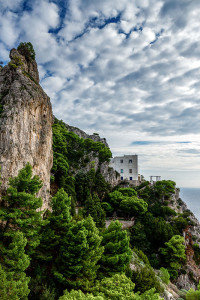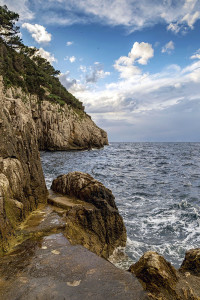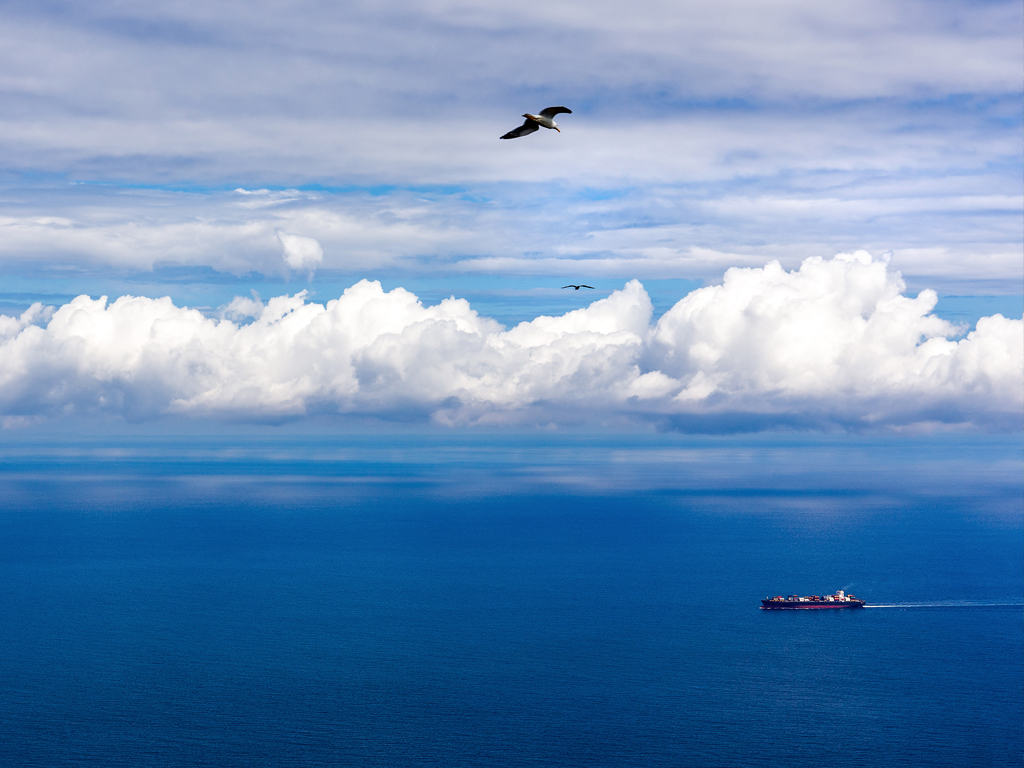
Mille e una nuvola
Cirri, cumuli, nembi e strati. Oppure solo nubi. Che rendono vivo ogni cielo
di Rossella Funghi | foto di Raffaele Lello Mastroianni
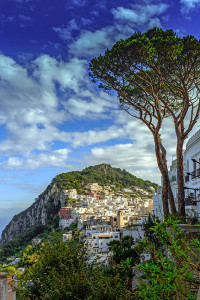 Leggere come panna montata o gonfie di pioggia, oggetto di fantasie infantili o soggetto di chi ama fermare in uno scatto quell’universo di forme e colori in continuo movimento. Teatrali, scenografiche e sempre diverse. Sulla nostra testa o laggiù, a far vivere un cielo come quando sorvolano la linea dell’orizzonte che magnifica appare dal belvedere della Migliera o fanno da corona alla roccia dei Faraglioni.
Leggere come panna montata o gonfie di pioggia, oggetto di fantasie infantili o soggetto di chi ama fermare in uno scatto quell’universo di forme e colori in continuo movimento. Teatrali, scenografiche e sempre diverse. Sulla nostra testa o laggiù, a far vivere un cielo come quando sorvolano la linea dell’orizzonte che magnifica appare dal belvedere della Migliera o fanno da corona alla roccia dei Faraglioni.
A Capri «con le stelle non s’esaurisce il programma delle meraviglie: ci sono anche le nuvole», che per essere armoniche devono essere tre, cinque o sette, come scriveva Edwin Cerio nella sua Guida inutile di Capri. «È risaputo che tutti gli elementi della decorazione usati dalla Natura, per formare un insieme veramente bello, debbono essere in numero dispari. Perché? Non c’è un perché – è una regola estetica. Orbene nel Cielo di Capri le nuvole d’ogni genere, i nugoloni da temporali di prima classe o le semplici nuvolette di bafuogno; i cirri, i cumuli e le pecorine, dette anche pecorelle, per rimare con acqua a catinelle, sono sempre in numero dispari». Fateci caso, è vero.
Sono figlie dell’aria e del sole e possono nascere ovunque. Cosa c’è di più semplice – e di più complesso – di un cielo percorso dalle nuvole? Frastagliate, rosate dal tramonto o trasudanti d’oro di primo mattino, minacciose e plumbee, le nuvole moltiplicano di continuo l’eterno incanto della metamorfosi del cielo. Stregati dalla loro bellezza e dal loro mutare, con occhi ritornati bambini possiamo dar vita a quel gioco antico che si ripete all’infinito dove vi si immaginano spumeggianti onde del mare, bianchi cavalli al galoppo, orsi, visi buffi, castelli, draghi. A tutte le età vale la pena di uscire dall’universo digitale, alzare lo sguardo al cielo e iniziare a giocare.
Qualche volta le osserviamo per cercare di capire che tempo farà. Quando il vento tira da sud-ovest il cielo intorno all’isola si riempie di nuvole. Belle, gonfie, cariche. Marinai e pescatori ne conoscono ogni segreto. Come Luigi Pecoraro che esce per mare quasi ogni giorno per pescare o per portare i turisti alla scoperta delle cale più belle dell’isola. «Il vento è il grande compagno delle nuvole» dice osservando l’azzurro sopra Marina Grande «e il libeccio è quello che “regn’ e arravàc” (riempie e svuota) il cielo portando grosse nuvole piene d’acqua, che veloci passano dopo l’acquazzone ma che nel giro di pochi minuti “assummann”, cioè ritornano con il loro carico di pioggia».
Tradizione vuole che premonizione di pioggia sia anche quella nuvola tubolare chiamata “seccia” protagonista del detto “Quando Monte Solaro ha il cappello preparate l’ombrello”.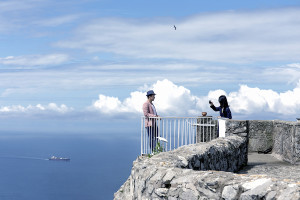
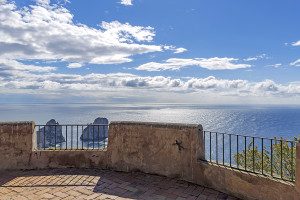
«La “seccia” non è altro che un accumulo di nebbia che si forma intorno alla montagna ed era indizio di venti che venivano da sud portando il loro carico di nuvole» spiega Rodolfo Ruocco, ‘O griec. Famiglia caprese da tre generazioni, classe 1933, 65 dei suoi anni li ha trascorsi in mare pescando. «Un proverbio veritiero forse trent’anni fa – dice – ma oggi è cambiato tutto. Una volta si vedeva una nuvola e si poteva dire “grecale per tre giorni”. Novembre, dicembre e gennaio erano i mesi di grecale, tramontana e maestrale. Venti che rendevano l’aria più tersa. Ora succede che a gennaio tira scirocco come fosse agosto, non ci si capisce più niente». Ma anche se il clima oggi è cambiato, quell’insieme di minuscole particelle di acqua così numerose da diventare visibili continua ad essere un importantissimo indicatore meteorologico.
Nel loro vagare hanno ispirato poesie e canzoni, e nuvole suggestive riempiono anche i cieli di chi l’isola l’ha dipinta. Tante tele sono percorse da quelle bianche e leggere o son plumbee di nuvole basse, gravide di tempesta perché «i cieli non sono dei lenzuoli stesi a far da fondo» come diceva John Constable, forse il maggior interprete di queste abitanti del cielo. E quelli dei dipinti di Antonino Leto, Carlo Perindani, Augusto Lovatti e Michele Federico sono vivi quanto i paesaggi che contengono. Vivi di nuvole.
Loro, le nuvole, continuano a viaggiare con tutta la loro leggerezza, si addensano minacciose, si soffermano a riposare tinte di rosa o d’azzurro.
A noi non resta che alzare gli occhi al cielo e stupirci della bellezza che vi troviamo, mai la stessa. Perché le nuvole sono adesso.
La montagna acchiappanuvole
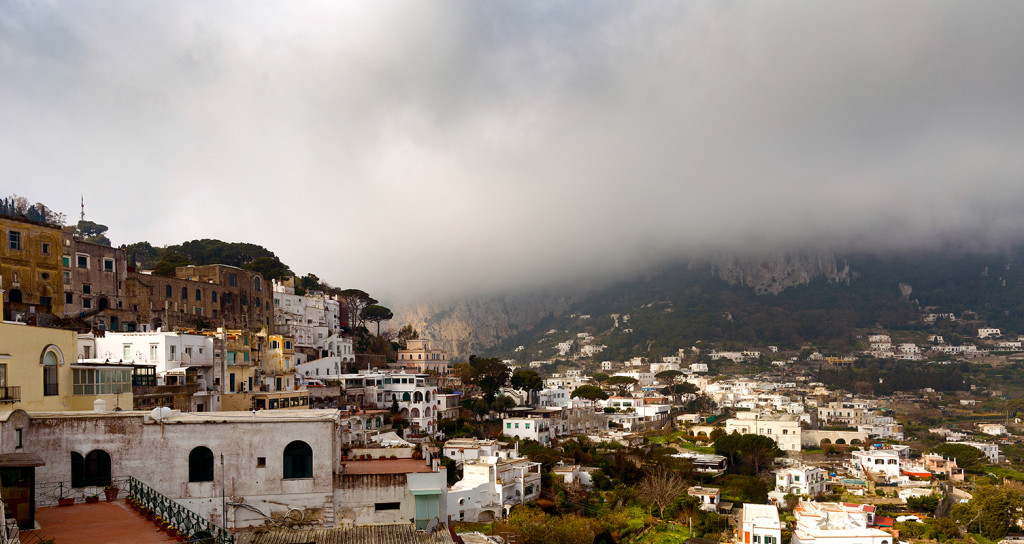 Con i suoi 589 metri il Solaro è la cima più alta di Capri. «Gli alpinisti, con la loro mentalità dongiovannesca, pensano che tutte le vette si possano violare e quando capitano a Capri ammiccano subito Monte Solaro. Senonché la montagna copre subito, castamente, la propria vetta con quella nuvola di scirocco che i marinai chiamano “seppia” – un cache-sexe di stoffa vaporosa – e fa intendere che non c’è niente da fare» scriveva Edwin Cerio nella Guida inutile di Capri. Quella corona di nubi altro non è che un fenomeno dovuto agli sbalzi termici tra terra e mare. L’aria marina calda e umida salendo incontra la roccia più fredda e condensa in una cortina che ha regalato alla montagna l’appellativo di “Acchiappanuvole”. | The mountain with its head in the clouds. At 589 metres high Mount Solaro is the highest peak on Capri. “The mountaineers, with their Don Juan mentality, think that you can violate every peak, and when they arrive on Capri they straightaway wink at Monte Solaro. But the mountain immediately covers up her peak, chastely, with those south-easterly clouds which the sailors call “cuttlefish” – a cache-sexe of filmy material – and she makes it clear that it’s no good trying anything,” wrote Edwin Cerio in the Useless Guide to Capri. That crown of clouds is actually a phenomenon resulting from the sudden changes in temperature between the land and the sea. As the warm, moist sea air rises, it meets the colder rock and condenses into a curtain that has given the mountain the nickname “Acchiappanuvole” (literally “Cloud-catcher”, someone with their head in the clouds).
Con i suoi 589 metri il Solaro è la cima più alta di Capri. «Gli alpinisti, con la loro mentalità dongiovannesca, pensano che tutte le vette si possano violare e quando capitano a Capri ammiccano subito Monte Solaro. Senonché la montagna copre subito, castamente, la propria vetta con quella nuvola di scirocco che i marinai chiamano “seppia” – un cache-sexe di stoffa vaporosa – e fa intendere che non c’è niente da fare» scriveva Edwin Cerio nella Guida inutile di Capri. Quella corona di nubi altro non è che un fenomeno dovuto agli sbalzi termici tra terra e mare. L’aria marina calda e umida salendo incontra la roccia più fredda e condensa in una cortina che ha regalato alla montagna l’appellativo di “Acchiappanuvole”. | The mountain with its head in the clouds. At 589 metres high Mount Solaro is the highest peak on Capri. “The mountaineers, with their Don Juan mentality, think that you can violate every peak, and when they arrive on Capri they straightaway wink at Monte Solaro. But the mountain immediately covers up her peak, chastely, with those south-easterly clouds which the sailors call “cuttlefish” – a cache-sexe of filmy material – and she makes it clear that it’s no good trying anything,” wrote Edwin Cerio in the Useless Guide to Capri. That crown of clouds is actually a phenomenon resulting from the sudden changes in temperature between the land and the sea. As the warm, moist sea air rises, it meets the colder rock and condenses into a curtain that has given the mountain the nickname “Acchiappanuvole” (literally “Cloud-catcher”, someone with their head in the clouds).
Tutte le nubi del mondo
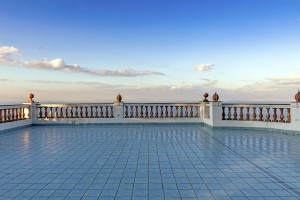 Le nuvole sono classificate dal 1986 nell’Atlante internazionale delle nubi curato dall’Organizzazione meteorologica mondiale. Ci sono dieci “generi” di nube definiti in funzione di dove si formano nel cielo e del loro aspetto. I dieci generi sono poi suddivisi in “specie”, che descrivono la forma e la struttura interna, e “varietà”, che descrivono la trasparenza e la disposizione delle nuvole. L’atlante è disponibile anche in versione digitale collegandosi al link wmocloudatlas.org. | All the clouds in the world. Clouds have been classified since 1986 in the International Cloud Atlas edited by the World Meteorological Organization. There are ten “genera” of clouds, defined according to where they form in the sky and what they look like. The ten genera are then sub-divided into “species”, which describe their shape and internal structure, and “varieties”, that describe their transparency and arrangement. The atlas is also available online at the website: wmocloudatlas.org.
Le nuvole sono classificate dal 1986 nell’Atlante internazionale delle nubi curato dall’Organizzazione meteorologica mondiale. Ci sono dieci “generi” di nube definiti in funzione di dove si formano nel cielo e del loro aspetto. I dieci generi sono poi suddivisi in “specie”, che descrivono la forma e la struttura interna, e “varietà”, che descrivono la trasparenza e la disposizione delle nuvole. L’atlante è disponibile anche in versione digitale collegandosi al link wmocloudatlas.org. | All the clouds in the world. Clouds have been classified since 1986 in the International Cloud Atlas edited by the World Meteorological Organization. There are ten “genera” of clouds, defined according to where they form in the sky and what they look like. The ten genera are then sub-divided into “species”, which describe their shape and internal structure, and “varieties”, that describe their transparency and arrangement. The atlas is also available online at the website: wmocloudatlas.org.
A thousand and one clouds
Cirrus, cumulus, nimbus and stratus. Or just clouds. That make all skies come alive
by Rossella Funghi | photos by Raffaele Lello Mastroianni
As light as whipped cream or swollen with rain, the object of childhood fantasies and the subject of those who like to capture that universe of continually moving shapes and colours with their cameras. Theatrical, spectacular and always different. Above our heads, or over there, making the sky come alive, as when they fly over the horizon line that appears so glorious from the Migliera, or when they make a crown around the rock of the Faraglioni. On Capri, “the programme of marvels doesn’t end with the stars: there are also the clouds,” which, to be harmonious, should be three, five or seven, as Edwin Cerio wrote in his Useless Guide to Capri. 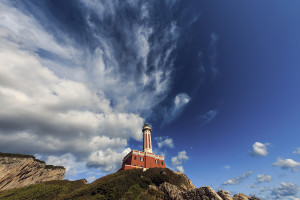 “It’s a well-known fact that all the decorative elements used by Nature, to make a truly beautiful whole, must be in odd numbers. Why? There’s no reason why – it’s just a rule of aesthetics. So in the Sky of Capri, the clouds of all kinds, the massed storm clouds in first class or the simple little clouds of the bafuogno (southerly wind); the cirrus, cumulus, and the fleecy clouds of a mackerel sky known as pecorelle, to rhyme with acqua a catinelle (raining buckets), always come in odd numbers.” Have a look and you’ll see it’s true. They’re daughters of the air and of the sun and can come up anywhere. What can be more simple – and more complex – than a sky criss-crossed with clouds? Irregular, rosy with the sunset, oozing gold in the early morning or heavy and threatening, the clouds continually multiply the eternal enchantment of the metamorphosis of the sky. Bewitched by their
“It’s a well-known fact that all the decorative elements used by Nature, to make a truly beautiful whole, must be in odd numbers. Why? There’s no reason why – it’s just a rule of aesthetics. So in the Sky of Capri, the clouds of all kinds, the massed storm clouds in first class or the simple little clouds of the bafuogno (southerly wind); the cirrus, cumulus, and the fleecy clouds of a mackerel sky known as pecorelle, to rhyme with acqua a catinelle (raining buckets), always come in odd numbers.” Have a look and you’ll see it’s true. They’re daughters of the air and of the sun and can come up anywhere. What can be more simple – and more complex – than a sky criss-crossed with clouds? Irregular, rosy with the sunset, oozing gold in the early morning or heavy and threatening, the clouds continually multiply the eternal enchantment of the metamorphosis of the sky. Bewitched by their 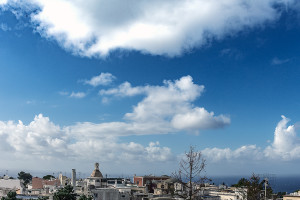 beauty and their changeability, if we look with the eyes of a child we can again play that old, infinitely repeating game of imagining them as foaming waves of the sea, white horses galloping, bears, comical faces, castles and dragons. Whatever age you may be, it’s worth coming out of the digital world, raising your eyes to the sky and starting to play the game. Sometimes we look at them to try to find out what the weather is going to be like. When the wind changes from south-west, the sky around the island fills with clouds. Beautiful, swollen, full of rain. Sailors and fishermen know all their secrets. Like Luigi Pecoraro, who goes out to sea almost every day to fish or take tourists to explore the most beautiful coves around the island. “The wind is the great companion of the clouds,” he says, watching the blue above Marina Grande, “and the south-west wind is the one that “gliègn’ e arravàc” (fills and empties) the sky, bringing large clouds full of water, that quickly pass after the cloudburst but that in just a few minutes “assummann”, that is, return again with their load of rain.” According to tradition, the tubular cloud known in Neapolitan dialect as “seccia” (from seppia, meaning cuttlefish) is also a premonition of rain, and is the subject of the saying “When Monte Solaro has a hat, get your umbrella out.” “The ‘seccia’ is simply an accumulation of mist that forms around the mountain and that used to be a sign of winds coming from the south and bringing the clouds with them,” explains Rodolfo Ruocco, ‘O griec.
beauty and their changeability, if we look with the eyes of a child we can again play that old, infinitely repeating game of imagining them as foaming waves of the sea, white horses galloping, bears, comical faces, castles and dragons. Whatever age you may be, it’s worth coming out of the digital world, raising your eyes to the sky and starting to play the game. Sometimes we look at them to try to find out what the weather is going to be like. When the wind changes from south-west, the sky around the island fills with clouds. Beautiful, swollen, full of rain. Sailors and fishermen know all their secrets. Like Luigi Pecoraro, who goes out to sea almost every day to fish or take tourists to explore the most beautiful coves around the island. “The wind is the great companion of the clouds,” he says, watching the blue above Marina Grande, “and the south-west wind is the one that “gliègn’ e arravàc” (fills and empties) the sky, bringing large clouds full of water, that quickly pass after the cloudburst but that in just a few minutes “assummann”, that is, return again with their load of rain.” According to tradition, the tubular cloud known in Neapolitan dialect as “seccia” (from seppia, meaning cuttlefish) is also a premonition of rain, and is the subject of the saying “When Monte Solaro has a hat, get your umbrella out.” “The ‘seccia’ is simply an accumulation of mist that forms around the mountain and that used to be a sign of winds coming from the south and bringing the clouds with them,” explains Rodolfo Ruocco, ‘O griec. 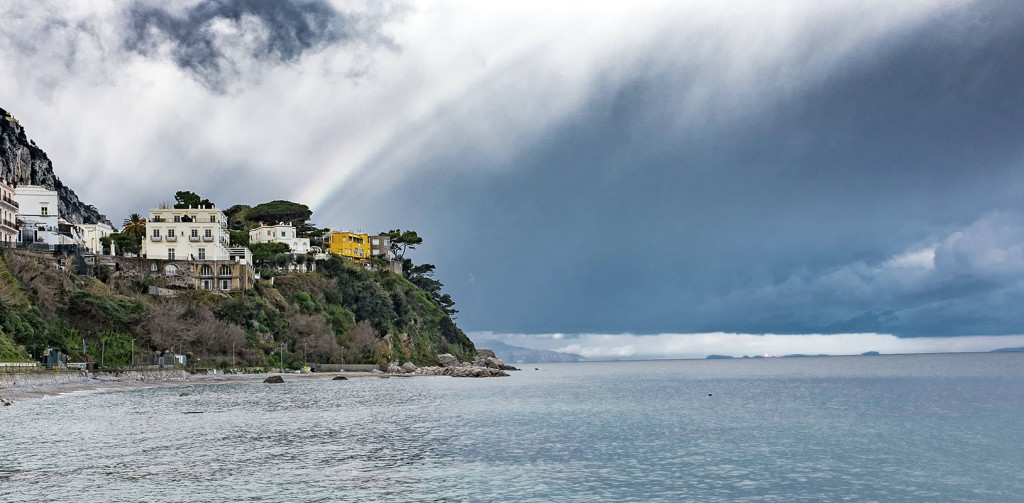
He comes from a Capri family of three generations, was born in 1933 and has spent 65 years of his life fishing on the sea. “Maybe that proverb was true thirty years ago,” he says, “but everything has changed now. Once you would see a cloud and you could say ‘there’ll be a north-easterly for three days’. November, December and January were the months of the north-east, north and north-west winds. Winds that make the air very clear. Now in January you can have a south-easterly like in August; you can’t understand anything any more.” But even if the climate is different now, that collection of miniscule particles of water so numerous that they become visible, continues to be a very important indicator of the weather. Their wanderings have inspired poetry and songs, and beautiful clouds also fill the skies in paintings of the island. Many paintings are criss-crossed by those fluffy white clouds, or are leaden with low storm clouds, heavy with rain, because the sky is not “a white sheet thrown behind the objects like the backdrop to a painted scene”: as John Constable, perhaps the greatest interpreter of these inhabitants of the skies, said. And the skies painted by Antonino Leto, Carlo Perindani, Augusto Lovatti and Michele Federico are as alive as the landscapes that contain them. Alive with clouds. Those clouds continue to travel in all their lightness, to build up threateningly, and to pause for a rest, tinged with pink or blue.
So all that remains is for us to raise our eyes to the sky and be amazed at the beauty that we find there, that is never the same.
Because the clouds are there right now.


